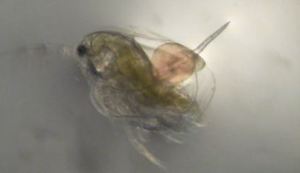Oct 20 2014
Organisms can be negatively affected by plastic nanoparticles, not just in the seas and oceans but in freshwater bodies too. These particles slow the growth of algae, cause deformities in water fleas and impede communication between small organisms and fish. These are the results of research carried out by Wageningen University and IMARES, part of Wageningen UR, published in the latest issue of Environmental Science and Technology. It is the first time that such effects of plastic on freshwater organisms have been studied.
 Recently born water fleas showed deformities after being exposed to nanoplastics
Recently born water fleas showed deformities after being exposed to nanoplastics
Plastic in the oceans (plastic soup) has been thought to seriously affect aquatic life for some time, but until now little research has been carried out into the levels and effects of plastics in the freshwater environment. ‘The main sources of plastic are on land, so it is important to also look at the effects of plastic on land’, says Professor Bart Koelmans, leader of the Wageningen University and IMARES research group. ‘We know that nanoplastic particles are released during processes such as the thermal cutting of plastics and 3D printing and when small plastic particles are abrasion by sand – a process that probably also takes place in nature.’
Koelmans and his team carry out detailed research into the effects of plastic in the aquatic environment. They have previously published articles on the presence of plastic in fish, the accumulation of toxic substances from plastic and the effects on marine organisms such as mussels and lugworms.
Kairomones
In the study into the effects of tiny plastic particles in freshwater, PhD candidate Ellen Besseling and student Bo Wang exposed water fleas to various nanoplastic concentrations. At higher concentrations, algae growth declined. Water fleas were also smaller following exposure to nanoplastics and their offspring malformed in various ways. ‘These are the first malformations that have been seen in freshwater organisms and we do not yet know how big the problem really is’, says Ellen Besseling. She believes that more research is needed into the sources, concentrations and effects of nanoplastic in water and on other organisms.
The effects were studied with and without kairomones in the water. These are chemical substances that fish emit that act as a warning for water fleas. The researchers found it intriguing that the effect of the kairomones appeared to be stronger in the presence of nanoplastic. They therefore believe that, as chemical communication is used extensively – to find a partner or food or to avoid predators such as fish – this also shows that subtle disturbances may be taking place at low concentrations that are not easy to detect using standard ecotoxicological tests but that may result in changes to the food web in exposed ecosystems over time.